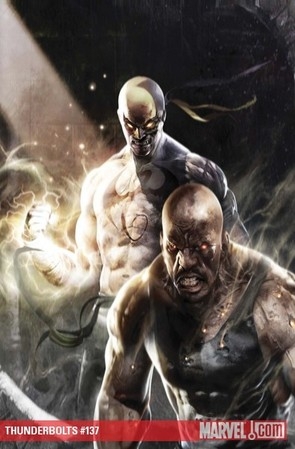Thunderbolts #137
By Zak Edwards
October 24, 2009 - 19:59
Marvel Comics
Writer(s): Rick Remender
Penciller(s): Mahmud A. Asrar
Inker(s): Rebecca Buchman
Colourist(s): Bruno Hang
Letterer(s): Albert Deschesne
Cover Artist(s): Francesco Mattina
$3.99 US
I came to Thunderbolts for Warren Ellis’ run just after the Civil War event turned the Marvel Universe into a sort of fascist state. With the series' focus on propaganda, militarization of homelands and the fact the cast of Thunderbolts were all bad people to some very extreme degrees, Thunderbolts was becoming a place in the Marvel Universe with a distinctive voice and implications. While the events of Civil War did set up for extensive commentary on the world around us, a very good argument to the direction of both Marvel and the outside came from the desk of Ellis. The original Thunderbolts team, consisting of characters like Moonstone, Venom (both Dark Avengers), and Songbird (who is now involved in Secret Warriors); have now come to the forefront of Marvel Comics, leaving a new set of Thunderbolts to enter under the direction of Andy Diggle, who struggled through the series with its forced cast changes and multiple crossovers. But Diggle has left, not doing a poor job either considering the circumstances. Now, another team has entered the fray with a one-shot story dealing largely with many superhero conventions while not fully using them to capability.
 |
| In terms of quality, the buck stops here! |
Mahmud A. Asrar’s art is similar to the story in some respect. It is very good and very standard. I didn’t find anything in this issue which made me feel either way. The panels do their job, the story is clearly told without any major hang-ups, and so on. He can handle everything Remender has given him without any problems and his action sequences are very well put together, particularly when looking at Iron Fist's martial arts hi-jinks. But the cover, Francesco Mattina, is incredible, well, except that none of what the cover says is in the story. Iron Fist joins very briefly and Power Man doesn’t join at all, and neither look like killer zombie, Spawn-inspired demons as they do on the cover. But it is a very cool cover despite these somewhat important technicalities.
4/10 Throw-away story, art that doesn’t leave an impression, the quality of this issue stops at the cover.
Related Articles:
Thunderbolts 160
Your First Look at Patrick Zircher's "Thunderbolts" #150 Variant
Thunderbolts #145/ UC Avengers 2 #4
Thunderbolts #144
Thunderbolts #143
Thunderbolts #141
Thunderbolts #137
Thunderbolts #130
Thunderbolts #128
Thunderbolts #127
